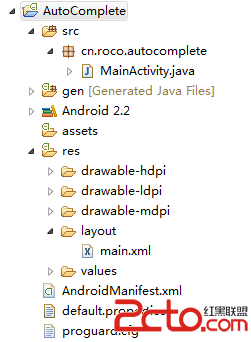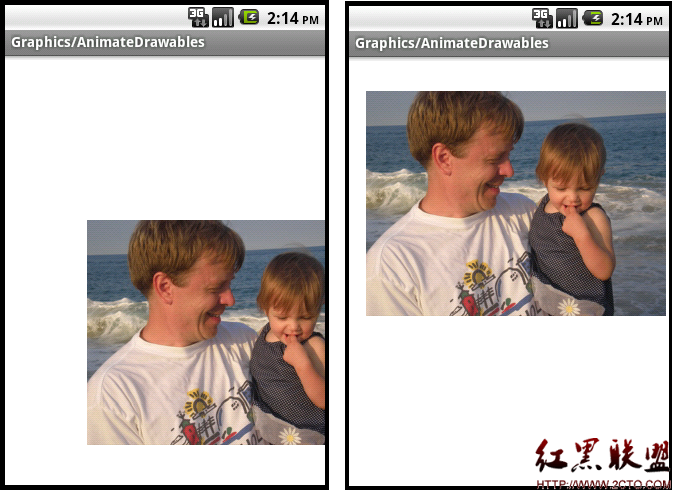MainActivity
Java代码
package org.wp.activity;
import android.app.Activity;
import android.graphics.Bitmap;
import android.graphics.Canvas;
import android.graphics.LinearGradient;
import android.graphics.Matrix;
import android.graphics.PorterDuffXfermode;
import android.graphics.Bitmap.Config;
import android.graphics.PorterDuff.Mode;
import android.graphics.Shader.TileMode;
import android.graphics.Paint;
import android.graphics.drawable.BitmapDrawable;
import android.os.Bundle;
import android.widget.ImageView;
/**
* ==========================================
* Matrix
* ==========================================
* The Matrix class holds a 3x3 matrix for transforming coordinates.
* Matrix does not have a constructor,
* so it must be explicitly initialized using either reset()
* - to construct an identity matrix,
* or one of the set..() functions
* (e.g. setTranslate, setRotate, etc.).
*
* Matrix 中文里叫矩阵,高等数学里有介绍
* 在图像处理方面,主要是用于平面的缩放、平移、旋转等操作。
* Matrix的操作,总共分为translate(平移),rotate(旋转),
* scale(缩放)和skew(倾斜)四种,
* 每一种变换在Android的API里都提供了set, post和pre三种操作方式
* 除了translate,其他三种操作都可以指定中心点。
*
* ==========================================
* createBitmap
* ==========================================
* public static Bitmap createBitmap (Bitmap source, int x, int y,
* int width, int height, Matrix m, boolean filter)
* Since: API Level 1 Returns an immutable bitmap from subset of the
* source bitmap, transformed by the optional matrix.
* It is initialized with the same density as the original bitmap.
* Parameters
* source The bitmap we are subsetting
* x The x coordinate of the first pixel in source
* y The y coordinate of the first pixel in source
* width The number of pixels in each row
* height The number of rows
* m Optional matrix to be applied to the pixels
* filter true if the source should be filtered.
* Only applies if the matrix contains more than
* just translation.
* Returns
* A bitmap that represents the specified subset of source
* Throws
* IllegalArgumentException
* if the x, y, width, height values are outside of the
* dimensions of the source bitmap.
*
* source 源 bitmap对象
* x 源坐标x位置
* y 源坐标y位置
* width 宽度
* height 高度
* m 接受的maxtrix对象,如果没有可以设置 为null
* filter 该参数仅对maxtrix包含了超过一个翻转才有效
*
* ==========================================
* LinearGradient
* ==========================================
* public LinearGradient (float x0, float y0, float x1, float y1, i
* nt color0, int color1, Shader.TileMode tile)
* Since: API Level 1 Create a shader that draws a linear gradient along a line.
* Parameters
* x0 The x-coordinate for the start of the gradient line
* y0 The y-coordinate for the start of the gradient line
* x1 The x-coordinate for the end of the gradient line
* y1 The y-coordinate for the end of the gradient line
* color0 The color at the start of the gradient line.
* color1 The color at the end of the gradient line.
* tile The Shader tiling mode
*
* 在android.graphics中我们可以找到有关Gradient字样的类,
* 比如LinearGradient 线性渐变、RadialGradient径向渐变 和 角度渐变SweepGradient 三种,
* 他们的基类为android.graphics.Shader。
*
* LinearGradient线性渐变
* 在android平台中提供了两种重载方式来实例化该类分别为,
* 他们的不同之处为参数中第一种方法可以用颜色数组,和位置来实现更细腻的过渡效果,
* 比如颜色采样int[] colors数组中存放20种颜色,则渐变将会逐一处理。
* 而第二种方法参数仅为起初颜色color0和最终颜色color1。
* LinearGradient(float x0, float y0, float x1, float y1,
* int[] colors, float[] positions, Shader.TileMode tile)
* LinearGradient(float x0, float y0, float x1, float y1,
* int color0, int color1, Shader.TileMode tile)
*
* 参数一为渐变起初点坐标x位置,参数二为y轴位置,
* 参数三和四分辨对应渐变终点,最后参数为平铺方式,这里设置为镜像
*
* 刚才已经讲到Gradient是基于Shader类,
* 所以我们通过Paint的setShader方法来设置这个渐变
* p.setShader(lg);
*
* ==========================================
* setXfermode
* ==========================================
* Xfermode
* 可以通过修改Paint的Xfermode来影响在
* Canvas已有的图像上面绘制新的颜色的方式 。
*
* 在正常的情况下,在已有的图像上绘图将会在其上面添加一层新的形状。
* 如果新的Paint是完全不透明的,那么它将完全遮挡住下面的Paint;
* 如果它是部分透明的,那么它将会被染上下面的颜色。
*
* 下面的Xfermode子类可以改变这种行为:
*
* AvoidXfermode 指定了一个颜色和容差,
* 强制Paint避免在它上面绘图(或者只在它上面绘图)。
* PixelXorXfermode 当覆盖已有的颜色时,应用一个简单的像素XOR操作。
*
* PorterDuffXfermode 这是一个非常强大的转换模式,使用它,
* 可以使用图像合成的16条Porter-Duff规则的任意





